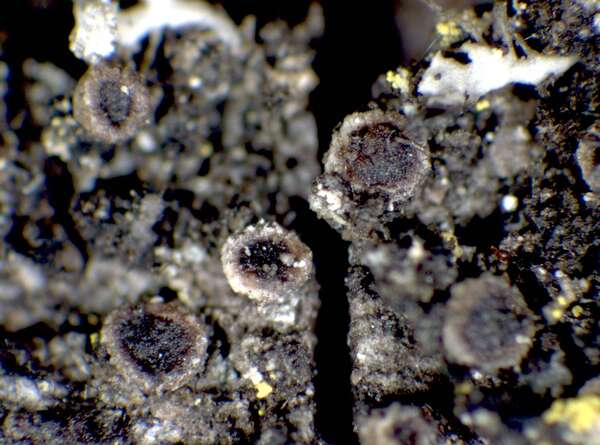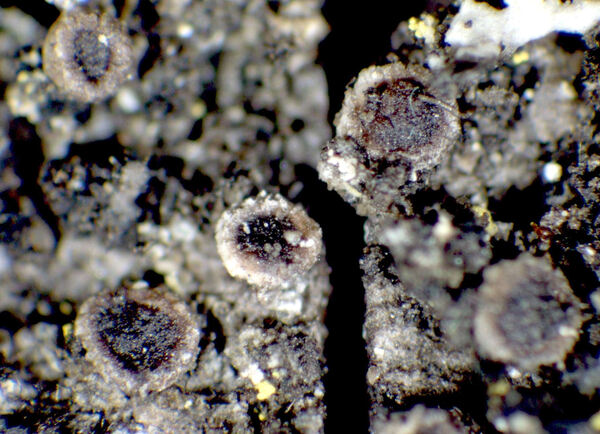Rinodina poeltiana Giralt & Obermayer
Herzogia, 9: 709, 1993.
Synonyms:
Distribution: N - TAA (Nascimbene & al. 2014, Nascimbene 2014).
Description: Thallus crustose, episubstratic, of contiguous to scattered areoles, without a distinct prothallus. Areoles grey to grey-brown, matt, flat to slightly convex, 0.1-0.3(-0.5) mm wide, blastidiate. Blastidia dark brown, 20-30(-40) µm thick, confluent, forming a continuous granulose crust, developing from the surface and margins of the areoles. Apothecia rare, lecanorine, at first adnate, then sessile, 0.2-0.5 mm across, with a usually flat, brown disc, and an entire, smooth to blastidiate, prominent thalline margin. Thalline exciple 50-80(-100) µm wide, corticate, I-; proper exciple 5-10 µm wide laterally, expanding to 40-60 µm in upper part, I-; epithecium reddish brown; hymenium colourless, 70-90 µm high; paraphyses 1.5-2 µm thick in lower part, the apical cells capitate and 3.5-5 µm wide; hypothecium colourless, c. 100 µm high. Asci 6-8-spored, clavate, the K/I+ blue tholus penetrated by a faintly amyloid apical cushion with parallel or diverging flanks, the wall K/I-, surrounded by a K/I+ blue outer layer, Lecanora-type. Ascospores 1-septate, brown, broadly ellipsoid, 14-18(-21) x 8-10(-12) µm, smooth, without torus or with a poorly developed torus, Pachysporaria-type. Pycnidia immersed in thallus. Conidia bacilliform, 3.5-4.5 µm long. Photobiont chlorococcoid. Spot tests: K-, C-, KC-, P-. Chemistry: without lichen substances.Note: a rather poorly known epiphytic species. The type material, from Austria, was growing on Salix alba.
Growth form: Crustose
Substrata: bark
Photobiont: green algae other than Trentepohlia
Reproductive strategy: mainly sexual
Poorly known taxon in need of further study
Commonnes-rarity: (info)
Alpine belt: absent
Subalpine belt: absent
Oromediterranean belt: absent
Montane belt: extremely rare
Submediterranean belt: extremely rare
Padanian area: absent
Humid submediterranean belt: absent
Humid mediterranean belt: absent
Dry mediterranean belt: absent

Predictive model
Herbarium samples
Growth form: Crustose
Substrata: bark
Photobiont: green algae other than Trentepohlia
Reproductive strategy: mainly sexual
Poorly known taxon in need of further study
Commonnes-rarity: (info)
Alpine belt: absent
Subalpine belt: absent
Oromediterranean belt: absent
Montane belt: extremely rare
Submediterranean belt: extremely rare
Padanian area: absent
Humid submediterranean belt: absent
Humid mediterranean belt: absent
Dry mediterranean belt: absent

Predictive model
| Herbarium samples |
 Index Fungorum
Index Fungorum
 GBIF
GBIF





